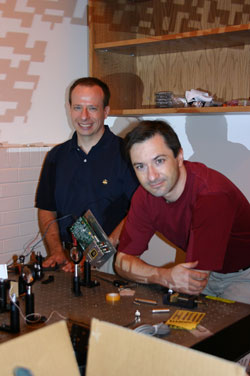Kelly and Baraniuk Unveil New Design for Single-Pixel Cameras
rice 发表于 2006/10/30 15:33 一品 百草园 (www.ywpw.com)
Using some new mathematics and a silicon chip covered with hundreds of thousands of mirrors the size of a single bacterium, Kevin Kelly, assistant professor of electrical and computer engineering and Richard Baraniuk, the Victor E. Cameron Professor of Electrical and Computer Engineering have come up with a more efficient design for digital cameras. Unlike a one-megapixel camera that captures one million points of light for every frame, this camera creates an image by capturing just one point of light, or pixel, several thousands of times in rapid succession. The new mathematics comes into play in assembling the high-resolution image – equal in quality to the one-megapixel image – from the thousands of single-pixel snapshots.
A peculiarity about the new camera may be that it works best when the light from the scene under view is scattered at random and turned into noise that looks like television tuned to a dead channel.
"White noise is the key," said Richard Baraniuk, "Thanks to some deep new mathematics developed just a couple of years ago, we're able to get a useful, coherent image out of the randomly scattered measurements."
Kevin Kelly built a working prototype camera using a digital micromirror device (DMD), and a single photodiode, which turns light into electrical signals. Today's typical retail digital camera has millions of photodiodes, or megapixels, on a single chip.

Today, it takes about five minutes to take a picture with the prototype camera, which fills an entire corner of a table in Kelly's laboratory. So far, only stationary objects have been photographed, but Kelly and Baraniuk say they should be able to adapt the "time-multiplexed" photographic technique to produce images similar to a home snapshot because the mirrors inside DMDs can alter their position millions of times per second. Their initial efforts are to develop the camera for scientific applications where digital photography is unavailable.
"For some wavelengths outside the visible spectrum, it's often too expensive to produce large arrays of detectors," Kelly said. "One of the beauties of our system is that it only requires one detector. We think this same methodology could be a real advantage in terahertz imaging and other areas."
The research is funded by the Defense Advanced Research Projects Agency, the Office of Naval Research, the National Science Foundation, Air Force Office of Scientific Research, and the Texas Instruments Leadership University Program.
For more information and photos, visit:
http://www.dsp.ece.rice.edu/cs/cscamera/
